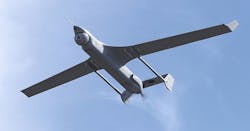Navy orders six RQ-21A Blackjack small tactical UAVs for naval and Marine Corps surveillance
PATUXENT RIVER NAS, Md., 2 June 2016. U.S. Navy officials are buying six new RQ-21A Blackjack small tactical unmanned aerial vehicles (UAVs) to provide surveillance capability for U.S. Marine Corps and Navy tactical commanders.
Officials of the Naval Air Systems Command at Patuxent River Naval Air Station, Md., announced a $71.6 million contract Tuesday to Boeing Insitu Inc. in Bingen, Wash., for six low-rate-initial-production lot-5 Blackjack unmanned aerial systems, which include air vehicles, ground control stations, launch and recovery equipment, and spare parts.
The Boeing Insitu RQ-21 is a twin-boom, single-engine, monoplane UAV for surveillance and reconnaissance. It an be launched and recovered on land or at sea without runways, using a pneumatic launcher and net-type recovery system.
The 81-pound Blackjack is eight feet long with a 16-foot wingspan designed to carry multi-sensor payloads in large pod below its nose. The UAV can fly as quickly as 104 miles per hour, cruises at 63 miles per hour, can fly as long as 24 hours, and can fly as high as 19,500 feet. It is a version of the Insitu Integrator UAV.
Related: Army asks Textron to provide Shadow unmanned aircraft and tactical data link retrofits
The multi-mission RQ-21A Blackjack's open-architecture payload bays can be customized with visible-light and infrared cameras, communications and other tools to give warfighters on the forward edge of battle situational awareness information.
It can integrate new payloads quickly, offers roll-on, roll-off capability to move the system quickly from ship to shore, and aboard cargo aircraft. The UAV can carry sensor payloads as heavy as 39 pounds.
The Blackjack's standard sensor payload consists of a visible-light imager, mid-wave infrared imager, laser rangefinder, infrared marker, communications, and automatic identification system.
The RQ-21A will provide persistent maritime and land-based tactical reconnaissance, surveillance, and target acquisition (RSTA) data collection and dissemination capabilities to the warfighter.
Related: The future of military unmanned aircraft
For the Marine corps it will provide the marine expeditionary force, divisions, and regiments with a dedicated intelligence, surveillance, and reconnaissance (ISR) system that sends information to the tactical commander in real time.
For the Navy the Blackjack will provide persistent RSTA information to Navy ships, Marine Corps land forces, Navy expeditionary combat command forces, and Navy special warfare units.
On this contract, Boeing Insitu will do the work in Bingen, Wash., and Hood River, Ore., and should be finished by October 2017. For more information contact Boeing Insitu online at www.insitu.com, or Naval Air Systems Command at www.navair.navy.mil.

John Keller | Editor
John Keller is editor-in-chief of Military & Aerospace Electronics magazine, which provides extensive coverage and analysis of enabling electronic and optoelectronic technologies in military, space, and commercial aviation applications. A member of the Military & Aerospace Electronics staff since the magazine's founding in 1989, Mr. Keller took over as chief editor in 1995.

